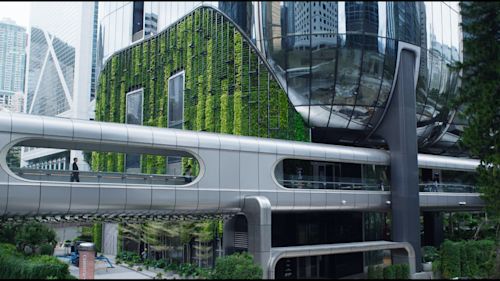Know Your Architecture: Japanese Metabolism and 5 Finest Examples
"Architecture is not permanent art, something complete and fixed, but rather something that grows in the future, expands, renews and develops."
The concept expressed by architect Kisho Kurokawa effectively sums up the point of view that accompanied the designers of Japanese Metabolism, an architectural movement born between the late 1950s and 1960s, during the post-war reconstruction phase characterized by rapid urban growth and strong technological innovation.
Birth of the Japanese Metabolism and Its Major Exponents
In nature, metabolism is a complex of synthetic biochemical reactions that enable living organisms to grow, renew, and maintain themselves. The term has entered everyday use in a figurative sense, to describe transformation over time—particularly in relation to changes and substitutions of constituent elements. Applied to architecture, this meant conceiving buildings and cities as living organisms, capable of changing, adapting, and regenerating themselves over time.
The term ‘Metabolism’ (メタボリズム,Metaborizumu) was proposed by Kiyonori Kikutake, one of the founding members of the movement, during the World Design Conference in Tokyo in 1960. On this occasion, positions were expressed that stood in contrast to the principles of the Modern Movement, which by then was considered to be reaching the end of its course; the ideas of the Metabolists were deemed too dynamic for the static urban vision of modernism.
At the end of the conference, the group published the manifesto titled ‘Metabolism 1960: The Proposals for New Urbanism’. In addition to Kikutake, the founding group included Kenzo Tange (mentor and central figure), Kisho Kurokawa, Fumihiko Maki, Masato Otaka, and Noboru Kawazoe (critic and theorist, and main author of the text).
5 Characteristics to Recognize Japanese Metabolism

Prefabricated "plug-in" modules
Living or functional elements designed to be manufactured in a factory and then attached to a main structure. This approach allowed for expansion, replacement, or reconfiguration without requiring complete demolition.
Central load-bearing structural core
Many Metabolist buildings feature a stable "trunk"—often made of reinforced concrete—from which modular units branch out, resembling cells or limbs.
Expandability over time
Projects were conceived as “incomplete” or evolving: each building or city was designed to grow and transform in response to future needs, in line with social development.
Hybridization between nature and technology
Metabolist architecture merged organic forms and engineering, drawing inspiration from biological processes while maximizing the use of available industrial technologies.
Functional and futuristic aesthetics
Angular lines, geometric repetition, visible capsules, and exposed materials (such as steel, concrete, and glass): the result was a "techno-organic" look, echoing a utopian vision of the urban future.
The 5 Most Iconic Examples of Japanese Metabolism
The shared vision of the Japanese Metabolist architects was to conceive cities and buildings as living organisms: modular, adaptable, and expandable. Their goal was to promote flexibility and sustainability, enabling architecture to evolve organically over time. These are the most representative examples of this movement:
Nakagin Capsule Tower – Kisho Kurokawa
The ultimate symbol of Metabolism, completed in 1972 in Tokyo’s Ginza district, remains one of the clearest and most radical expressions of the movement. The tower consisted of 140 prefabricated capsules attached to two reinforced concrete cores using high-strength bolts. Made of riveted steel, the capsules featured a compact layout with minimal interiors and a distinctive circular window, embodying an industrial aesthetic. Despite its iconic value, a lack of maintenance led to progressive structural deterioration, culminating in its demolition in 2022. Some capsules were carefully dismantled, restored, and transferred to museums—such as the Museum of Modern Art (MoMA) in New York—or donated to collectors and cultural institutions.
Shizuoka Press and Broadcasting Center – Kenzo Tange
Completed in 1967, the Shizuoka Press and Broadcasting Center was the first concrete realization of a central core concept, around which prefabricated modules are arranged—in this case, to house office spaces. The structure is organized around a circular load-bearing core, with 13 modular units attached. Although it was designed for future expansion, the building has remained largely unchanged. Nevertheless, it stands as a testament to the vision of a city in “organic evolution,” and it remains one of the few Metabolist buildings still in operation today, preserved through ongoing maintenance.
Sky House – Kiyonori Kikutake
A private experimental residence located in Tokyo and completed in 1958, Kiyonori Kikutake’s Sky House is considered one of the precursor works of Japanese Metabolism, as it was built two years before the official publication of the movement’s manifesto. The project fully embodies metabolist principles: a housing platform elevated above the ground on four reinforced concrete pillars, conceived as a fixed and permanent core to which mobile housing modules could be attached or replaced, adapting over time to changes in the family or broader social transformations. The building has undergone several restorations while maintaining its original structure; it remains the property of the Kikutake family and is still used as a private home.
Marine City – Kiyonori Kikutake
Although it was never realized, Marine City remains a powerful symbol of the Metabolist Movement. Designed by Kikutake in the early 1960s, the project envisioned a utopian floating city: modular platforms, infinitely expandable on the sea—an urban dream of unlimited growth and a perfect metaphor for urban metabolism.
Yamanashi Culture Hall – Kenzo Tange
Located in Kōfu, Yamanashi Prefecture, the Yamanashi Press and Broadcasting Center—designed by Kenzo Tange and completed in 1966—was originally intended to house a printing press, a radio station, and a television station. Architecturally, the building is distinguished by its 16 cylindrical reinforced concrete columns, each 5 meters in diameter, which serve as load-bearing elements and house vertical systems such as elevators, staircases, and mechanical services. Around these columns, modular and independent spaces were developed, conceived as units that could be easily replaced or expanded. Structurally, the building made use of prefabrication and an innovative load-bearing system for its time, which allowed great flexibility in the interior layout and facilitated future adaptations. Today, renamed the Yamanashi Cultural Hall, it continues to function as a cultural venue and office space for local broadcasters.
Metabolism redefined the very idea of architecture and urban planning: no longer as eternal monuments, but as organisms in constant transformation. Although many projects were never realized or have since been altered, their theoretical and visual legacy remains alive. Today, in the face of challenges like climate change and rapid urbanization, the Metabolist principles of modularity, sustainability, and adaptability are more relevant than ever.



